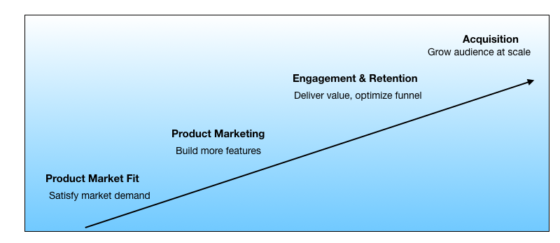
One of the most valuable and satisfying experiences a performance marketer can have in their career is scaling a growth operation from scratch. At Matrix, we went from spending $0 to a number that represented positive, baseline growth for PowerWatch. As head of marketing, I can attest to how rewarding that experience was and how important the phase was in building foundational growth for our company.
There are all kinds of shortcuts on the road to growth. Shortcuts are by no means fatal, but they do step around the critical early stages where investment in performance marketing is key.
Companies will outsource marketing to an agency, or buy cheap traffic from non-core markets to prove out vanity metrics. They’ll hire a brand-focused CMO to build out a massive marketing team – and discount performance marketing completely. Again, these things aren’t fatal, but long-term growth ultimately means investing in a combination of areas that function together in order to scale a product to its maximum potential.
The growth trajectory for a startup typically looks something like this:

Over time, it looks more like this:

In the beginning, performance marketing acts as a flywheel to push the business from one stage to the next. Later, brand marketing comes in to serve the goals of the company as it begins to grow and mature. (for example, when LTV becomes equally important as conversion.)
The 360 marketing leader understands the tradeoffs and benefits of each component and when to prioritize one over the other. They do this while establishing the foundational support for all marketing departments to grow.
Below, I’ll discuss brand marketing and performance marketing in detail. We’ll see how they’re separate but equal levers to be used at different stages in a company’s growth.
Brand Marketing
Brand marketing aims to grow a brand’s equity in the marketplace. It makes up a brand’s identity – who they are, what they do, and their reputation for trustworthiness and quality. A brand marketing team produces key materials that all other marketing teams rely on such as brand visuals (logo, iconography), customer archetypes, and messaging. They define the intangibles – your mission, your philosophy, and the customer journey.
PROS – Brand Marketing
- Primes the brand to compete in the marketplace
- Establishes a framework for appealing to category + customer segments
- Works towards brand commerce vs. marketplace commoditization (why I should buy your product vs. cheap/generic version on Amazon)
- Builds brand loyalty and trust
CONS – Brand Marketing
- No product validation
- No audience building
- No immediate return on investment (ROI)
- Fixed messaging
Performance Marketing
Performance, also called direct response marketing, is designed to get an immediate action by compelling a user to do something. These actions include placing an order, visiting your website, or signing up to your mailing list.
PROS – Performance Marketing
- Validates new products + features
- Quickly grows marketing funnel
- Focus on experimentation for best results (A/B testing)
- Captures key metrics upon which all decisions will be made:
- click-thru-rate (CTR)
- cost per click (CPC)
- conversion rate (CTR)
- return-on-ad-spend (ROAS)
- cost to acquire a customer (CAC)
- customer lifetime value (CLTV or LTV)
CONS – Performance Marketing
- Doesn’t convey brand mission or point of view
- Doesn’t establish brand trust
- Doesn’t create customer connection and/or emotional loyalty
- Limited unification in digital presence
The goal is to get quality conversions at the lowest possible cost (CAC + ROAS). After that the goalpost shifts to decreasing customer acquisition costs while increasing customer lifetime value (CLTV).
Decreasing CAC is getting tougher each year as the advertising space on social media and search becomes increasingly crowded. Because of this, it’s even more important to make sure the customers you acquire come back time and time again.
This is where brand marketing comes back into play. By investing in every touchpoint of the customer journey, customer loyalty and lifetime value (CLTV) lift together.
In 2019, the entire buyer journey has shifted to the customer experience. In the direct-to-consumer space especially, consumers feel most connected to brands that “know” them. They engage with content that aims to bring them into a community and lifestyle, rather than just sell them any old regular product.
This is exactly how consumer brands have a competitive advantage against big box retailers and department stores. While they still need to fight in an overly saturated digital marketplace, they can stand out by pairing the fast-paced iteration of performance marketing efforts with the brand building elements of brand marketing.
In summary:
When To Use Performance Marketing
- To quickly build a viable, renewable sales channel
- To expand the sales & marketing funnel
- To validate a product or feature by proving out demand
When To Use Brand Building
- To establish, communicate and refine brand voice + mission
- To build community around your purpose
- To create an emotional connection
- To foster loyalty (brand evangelists) leading to organic growth
When To Use Both
- To capture customer reviews and social proof
- To acquire press and blogger/journalist reviews
- To use both of the above in performance marketing efforts
- To unify creative + messaging across ALL marketing channels
To summarize, performance and brand marketing are different philosophies. By viewing them as different but equal levers used at different stages in a company’s growth, a flexible framework can be established for immediate growth and long-term results.